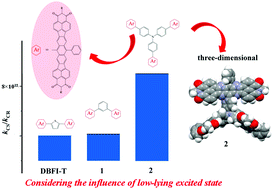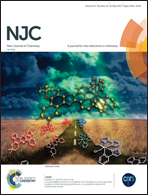Theoretical design of three-dimensional non-fullerene acceptor materials based on an arylenediimide unit towards high efficiency organic solar cells†
Abstract
Two non-fullerene acceptors with a three-dimensional structure based on the reported DBFI-T molecule (an arylenediimide-containing system) were theoretically modelled to study their performance as acceptor materials in organic solar cells (OSCs). Many performance indices were employed to judge the molecules designed by us on the basis of density functional theory/time-dependent density function theory (DFT/TDDFT). Compared with DBFT-T, the modelled molecule 2 has a larger density of states in the lowest unoccupied molecular orbitals and more low lying excited states in the anion, which greatly favors the charge separation process in OSCs. The comparison of charge separation/recombination rates (kCS/kCR) evaluated by considering the influence of low-lying excited states at the PSEHTT (donor)/acceptor interface suggests that molecules 1 and 2 have a higher short-circuit current density (Jsc) than DBFI-T, since they have higher kCS and lower kCR. Moreover, many other important parameters, such as the open circuit voltage, energetic driving force and absorption spectrum were also provided, which further illustrates the efficacy of molecules 1 and 2 in OSCs.



 Please wait while we load your content...
Please wait while we load your content...